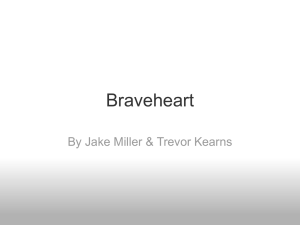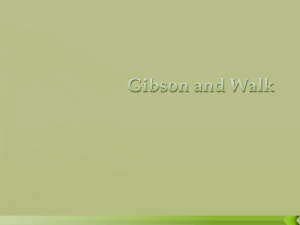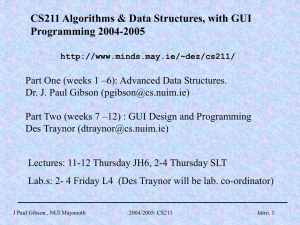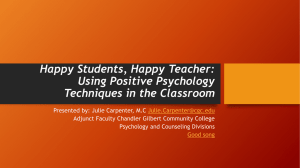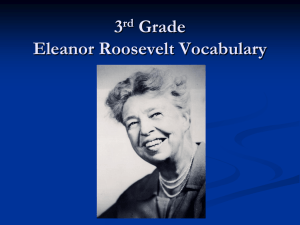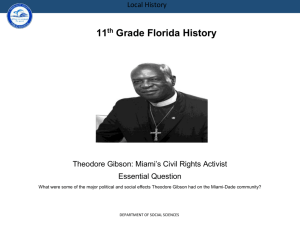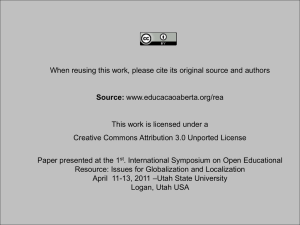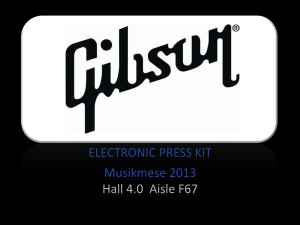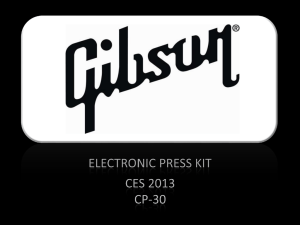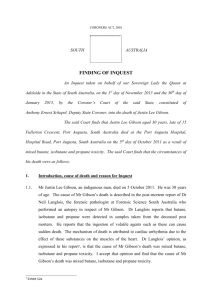Eleanor Jack Gibson - University of Tulsa
advertisement
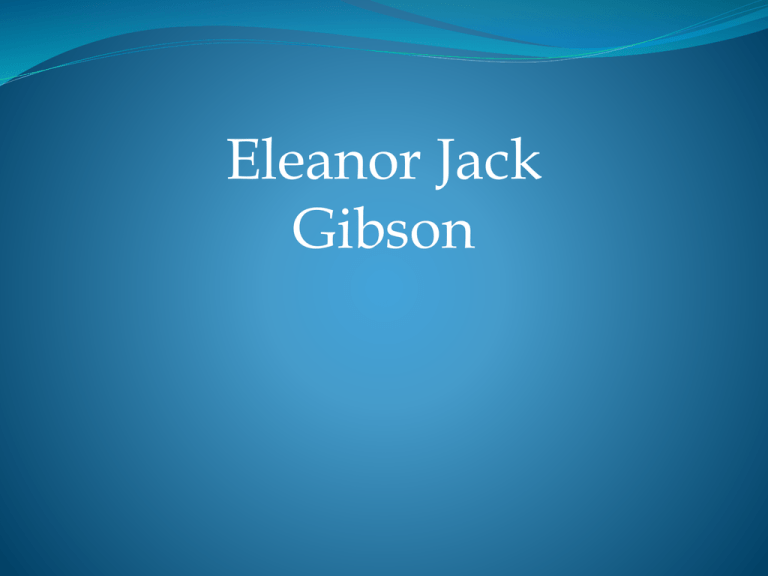
Eleanor Jack Gibson Background Information •Childhood •Family •Education http://www.collegeahuntsic.qc.ca/P agesdept/Sc_Sociales/psy/introsite/i mages/GibsonEleanor.jpg Personal and Professional Obstacles •Eleanor was discouraged from childhood from pursuing an education •The college she started out did not believe in giving doctorate degrees to women, only allowing them to obtain master’s degrees. •After finishing college and graduate school, Gibson began her career in the midst of the Great Depression. •Her and her husband, James Gibson had financial difficulties because of the Great Depression so she had to delay some of her works to support him and his professional commitments Personal and Professional Obstacles •In 1935 she spent a year at Yale University. There, Robert Yerkes refused to admit her at first because he said she was incompetent. •While at Yale, Gibson’s research animals were removed several times by disgruntled anonymous coworker. •Not only segregated against in the lab, no women were also allowed in the living, dining, or recreational quarters •During the WWII her family had to move she gave up her work once again to help her husband and for four years she had no contact with the psychology world as far as research concerns and an academic position Historical Influences and Antecedents Kurt Koffka •Taught Eleanor in college as a visiting faculty member •Was the first to instill a love of developmental psychology in Gibson •Worked a lot with children, specifically learning and avoidance habits •Postulated infants’ perception is based on consequential learning •Unlike Gibson, applied Gestalt principles to his studies since he was one of the main founders of the field http://organizations.uncfsu.edu/psichi/Hi story%20Pic/koffka.gif Historical Influences and Antecedents Howard Liddell •Worked alongside Gibson at Smith College •Primarily focused on baby animals, specifically infant sheep and goats •Used electric shocks on the animals to test conditioning and developmental changes •Gibson was fascinated by this and helped Liddell in the lab, but the lab was shut down before she had gotten a chance to do much •Reinforced Gibson’s goal of studying developmental psychology, especially in infants http://www.mooseyscountrygarden.com/ cats-dogs/lamb-sheep-field.jpg Historical Influences and Antecedents Psyche Cattell •Daughter of famous psychologist James McKean Cattell •Adapted the Stanford-Binet test to fit infants; the new test was named the Cattell Infant Intelligence Scale •Could be used on babies just a few months old •Shed light on what was thought to be untestable- infant IQ •Finally allowed psychology to quantify the mental development and intelligence of young babies http://www.indiana.edu/~intell/profileIm ages/newImages/psychecattell.jpg Historical Influences and Antecedents James Gibson •Eventual husband of Eleanor Gibson •Focused on visual perception of adults, specifically of jet pilots in combat •Influenced his wife to begin studying perception in children and ecological psychology •Eleanor adapted his thoughts on affordance to also fit children and infants •Eleanor also helped develop the field of ecological psychology after James’ death in 1979 http://www.collegeahuntsic.qc.ca/Pagesd ept/Sc_Sociales/psy/introsite/images/gibs on.gif Research and Work Overview •Perception, Development, Learning •Conditioning with Liddell at Smith college •Graduate thesis with Hull-differentiation •Perception with J. Gibson •Differentiation •Enrichment •Visual Cliff •Developmental after J. Gibson’s death •Reading http://www.ferrum.edu/thanlon/profwrit/Eleanor JackGibson_files/image002.jpg Research and Work Differentiation •Differentiation v. Enrichment •Postman’s Critique Attack on associationism Incomplete No testable hypotheses Actually associationism anyway •Gibsons’ response Theory in beginning stages Research with Visual Cliff http://www.universityofcalifornia.edu/senate/inmem oriam/images/Postman.jpg Dr. Leo Postman Research and Work Visual Cliff •Goats •Affordances and Affordance Theory •Traversability of Surfaces Rigid v. Waterbed Walking v. Crawling http://www.catherineshafer.com/images/visual_cliff_1_.png Research and Work Reading •Differentiation of Letters •Pronouncability and Meaningfulness http://kidedu.org/images/d/d8/Abecedaire.gif Influences of Eleanor Gibson •Greatly influenced R.D. Walk with his subsequent work on the visual cliff •Developed the first ever Infant Study Laboratory •Influenced her husband James Gibson’s creation of ecological psychology •Predicted the future evolution of developmental psychology •Although most of her work was with her husband or in cooperation with other psychologists, Eleanor Gibson still greatly influenced them through her work behind the scenes and out of the limelight. Summary •Completed her graduate training in one year •Received Doctorate from Yale in 1938 •She began in the period of the Great Depression •She was a very caring and empathetic person, treating her students as colleagues •She developed her theory of avoidance learning, based on studies of children; also worked on Perceptual Learning •“Visual Cliff,” discovered that baby animals avoided a simulated cliff constructed by suspending a piece of glass above the floor Summary •“Visual Cliff” perception of infants aged 6-14 months •Biggest Accomplishment in Field of Perceptual Development in Children and Infants •Wrote: “An Odyssey in Learning Perception (1991); Perceiving the Affordamus: A Portrait of Two Psychologists (2002) •Wrote a grant proposal (Spencer Foundation) support post-doctoral year in her laboratory •1975- established infant study laboratory; ecological psychology •G. Stanley Hall Award in APA for distinguished scientific contribution in 1968; 1983 National Medal for Science; 1992 Lifetime Achievement Award Bibliography •Association for Psychological Science. (2003). “Gibson Was a Dominant Influence.” Washington, D.C. Volume16, Number 4. •Caudle, F.M. (2003). Eleanor Jack Gibson. American Psychologist. Volume 58(12). P. 1890-91. •Gale Encyclopedia of Psychology. 2nd Ed. Gale Group. 2001 •Gibson, E. J.(1970). The ontogeny of reading. American Psychologist, 25(2). Retrieved June 17, 2009, from EBSCOhost database. EBSCOhost database. •Gibson, E. J., Bishop, C. H., Schiff, W., Smith, J. (1964). Comparison of meaningfulness and pronouncability as grouping principles in the perception and retention of verbal material. The Journal of Experimental Psychology, 67(2). Retrieved June 15, 2009, from EBSCOhost database. •Gibson, J. J., Gibson, E. J. (1955a). Perceptual learning: Differentiation or enrichment? Psychological Review, 62(1). Retrieved June 13, 2009, from EBSCOhost database. •Hochman, Susan K. Psyche Cattell. Webster University. (n.d.) Retrieved June 16, 2009, from http://www.webster.edu/~woolflm/cattell.html •J.J. Gibson. (n.d.) In New World Encyclopedia Online. Retrieved June 16, 2009, from http://www.newworldencyclopedia.org/entry/J._J._Gibson •Kurt Koffka. (n.d.) In New World Encyclopedia Online. Retrieved June 16, 2009, from http://www.newworldencyclopedia.org/entry/Kurt_Koffka •O’Connell, A. N., Russo, N. F. (Eds.). (1990). Women in Psychology: A BioBibliographic Sourcebook. New York: Greenwood Press. •Schultz, Duane P. and Sydney Ellen Schultz. A History of Modern Psychology. United •States: Thomson Wadsworth, 2008. •Szokolszky, A. (Interviewer) & Gibson, E. (Interviewee). (1997). An interview with Eleanor Gibson. Ecological Psychology, 15(4). Retrieved June 15, 2009, from EBSCOhost database.
